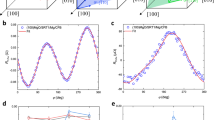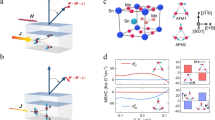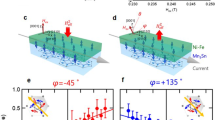Abstract
Large spin–orbit torques (SOTs) generated by topological materials and heavy metals interfaced with ferromagnets are promising for next-generation magnetic memory and logic devices. SOTs generated from y spin originating from spin Hall and Edelstein effects can realize field-free magnetization switching only when the magnetization and spin are collinear. Here we circumvent the above limitation by utilizing unconventional spins generated in a MnPd3 thin film grown on an oxidized silicon substrate. We observe conventional SOT due to y spin, and out-of-plane and in-plane anti-damping-like torques originated from z spin and x spin, respectively, in MnPd3/CoFeB heterostructures. Notably, we have demonstrated complete field-free switching of perpendicular cobalt via out-of-plane anti-damping-like SOT. Density functional theory calculations show that the observed unconventional torques are due to the low symmetry of the (114)-oriented MnPd3 films. Altogether our results provide a path toward realization of a practical spin channel in ultrafast magnetic memory and logic devices.
This is a preview of subscription content, access via your institution
Access options
Access Nature and 54 other Nature Portfolio journals
Get Nature+, our best-value online-access subscription
$29.99 / 30 days
cancel any time
Subscribe to this journal
Receive 12 print issues and online access
$259.00 per year
only $21.58 per issue
Buy this article
- Purchase on Springer Link
- Instant access to full article PDF
Prices may be subject to local taxes which are calculated during checkout




Similar content being viewed by others
Data availability
The data that support the findings of this study are available from the corresponding authors on reasonable request.
Code availability
The code used for the findings of this study are available from the corresponding authors on reasonable request.
References
Dieny, B. et al. Opportunities and challenges for spintronics in the microelectronics industry. Nat. Electron. 3, 446–459 (2020).
Grimaldi, E. et al. Single-shot dynamics of spin–orbit torque and spin transfer torque switching in three-terminal magnetic tunnel junctions. Nat. Nanotechnol. 15, 111–117 (2020).
Manchon, A. et al. Current-induced spin-orbit torques in ferromagnetic and antiferromagnetic systems. Rev. Mod. Phys. 91, 035004 (2019).
Chernyshov, A. et al. Evidence for reversible control of magnetization in a ferromagnetic material via spin–orbit magnetic field. Nat. Phys. 5, 656 (2008).
Miron, I. M. et al. Perpendicular switching of a single ferromagnetic layer induced by in-plane current injection. Nature 476, 189–193 (2011).
Liu, L., Lee, O. J., Gudmundsen, T. J., Ralph, D. C. & Buhrman, R. A. Current-induced switching of perpendicularly magnetized magnetic layers using spin torque from the spin Hall effect. Phys. Rev. Lett. 109, 096602 (2012).
Cho, S., Chris Baek, S., Lee, K.-D., Jo, Y. & Park, B.-G. Large spin Hall magnetoresistance and its correlation to the spin–orbit torque in W/CoFeB/MgO structures. Sci. Rep. 5, 14668 (2015).
Fukami, S., Anekawa, T., Zhang, C. & Ohno, H. A spin–orbit torque switching scheme with collinear magnetic easy axis and current configuration. Nat. Nanotechnol. 11, 621–626 (2016).
Mellnik, A. R. et al. Spin-transfer torque generated by a topological insulator. Nature 511, 449–451 (2014).
Fan, Y. et al. Magnetization switching through giant spin–orbit torque in a magnetically doped topological insulator heterostructure. Nat. Mater. 13, 699–704 (2014).
Kondou, K. et al. Fermi level dependent charge-to-spin current conversion by Dirac surface state of topological insulators. Nat. Phys. 12, 1027–1032 (2016).
DC, M. et al. Room-temperature high spin–orbit torque due to quantum confinement in sputtered BixSe(1−x) films. Nat. Mater. 17, 800–807 (2018).
Khang, N., Khang, D., Ueda, Y. & Hai, P. N. A conductive topological insulator with large spin Hall effect for ultralow power spin–orbit torque switching. Nat. Mater. 17, 808–813 (2018).
Fukami, S., Zhang, C., DuttaGupta, S., Kurenkov, A. & Ohno, H. Magnetization switching by spin–orbit torque in an antiferromagnet–ferromagnet bilayer system. Nat. Mater. 15, 535–541 (2016).
Oh, Y. W. et al. Field-free switching of perpendicular magnetization through spin–orbit torque in antiferromagnet/ferromagnet/oxide structures. Nat. Nanotechnol. 11, 878–884 (2016).
Zhang, W. et al. Giant facet-dependent spin–orbit torque and spin Hall conductivity in the triangular antiferromagnet IrMn3. Sci. Adv. 2, e1600759 (2016).
Chen, J.-Y. et al. Field-free spin–orbit torque switching of composite perpendicular CoFeB/Gd/CoFeB layers utilized for three-terminal magnetic tunnel junctions. Appl. Phys. Lett. 111, 012402 (2017).
Nan, T. et al. Controlling spin current polarization through non-collinear antiferromagnetism. Nat. Commun. 11, 4671 (2020).
Macneill, D. et al. Control of spin–orbit torques through crystal symmetry in WTe2/ferromagnet bilayers. Nat. Phys. 13, 300–306 (2017).
Shi, S. et al. All-electric magnetization switching and Dzyaloshinskii–Moriya interaction in WTe2/ferromagnet heterostructures. Nat. Nanotechnol. 14, 945–949 (2019).
Song, P. et al. Coexistence of large conventional and planar spin Hall effect with long spin diffusion length in a low-symmetry semimetal at room temperature. Nat. Mater. 19, 292–298 (2020).
Qi, X.-L. & Zhang, S.-C. Topological insulators and superconductors. Rev. Mod. Phys. 83, 1057–1106 (2011).
Zhao, B. et al. Unconventional charge–spin conversion in Weyl-semimetal WTe2. Adv. Mater. 32, 2000818 (2020).
Baek, S. C. et al. Spin currents and spin–orbit torques in ferromagnetic trilayers. Nat. Mater. 17, 509–513 (2018).
Lee, D. & Lee, K. Spin-orbit torque switching of perpendicular magnetization in ferromagnetic trilayers. Sci. Rep. 10, 1772 (2020).
Li, X. et al. Materials requirements of high-speed and low-power spin–orbit–torque magnetic random-access memory. IEEE J. Electron Devices Soc. 8, 674–680 (2020).
Mangin, S. et al. Current-induced magnetization reversal in nanopillars with perpendicular anisotropy. Nat. Mater. 5, 210–215 (2006).
Yu, G. et al. Switching of perpendicular magnetization by spin–orbit torques in the absence of external magnetic fields. Nat. Nanotechnol. 9, 548–554 (2014).
Chen, S. et al. Free field electric switching of perpendicular magnetized thin film by spin current gradient. ACS Appl. Mater. Interfaces 11, 30446–30452 (2019).
Shu, X. et al. Field-free switching of perpendicular magnetization induced by longitudinal spin–orbit–torque gradient. Phys. Rev. Appl. 17, 024031 (2022).
You, L. et al. Switching of perpendicularly polarized nanomagnets with spin orbit torque without an external magnetic field by engineering a tilted anisotropy. Proc. Natl Acad. Sci. USA 112, 10310–10315 (2015).
Liu, L. et al. Current-induced magnetization switching in all-oxide heterostructures. Nat. Nanotechnol. 14, 939–944 (2019).
Zhao, Z., Smith, A. K., Jamali, M. & Wang, J. P. External-field-free spin Hall switching of perpendicular magnetic nanopillar with a dipole-coupled composite structure. Adv. Electron. Mater. 6, 1901368 (2020).
Krizakova, V., Garello, K., Grimaldi, E., Kar, G. S. & Gambardella, P. Field-free switching of magnetic tunnel junctions driven by spin–orbit torques at sub-ns timescales. Appl. Phys. Lett. 116, 232406 (2020).
Liu, L. et al. Symmetry-dependent field-free switching of perpendicular magnetization. Nat. Nanotechnol. 16, 277–282 (2021).
Wang, M. et al. Field-free switching of a perpendicular magnetic tunnel junction through the interplay of spin–orbit and spin–transfer torques. Nat. Electron. 1, 582–588 (2018).
Avci, C. O. et al. Interplay of spin–orbit torque and thermoelectric effects in ferromagnet/normal-metal bilayers. Phys. Rev. B 90, 224427 (2014).
Chen, Y.-T. et al. Theory of spin Hall magnetoresistance. Phys. Rev. B 87, 144411 (2013).
Zhang, W., Han, W., Jiang, X., Yang, S.-H. & Parkin, S. S. P. Role of transparency of platinum–ferromagnet interfaces in determining the intrinsic magnitude of the spin Hall effect. Nat. Phys. 11, 496–503 (2015).
Pai, C. F., Ou, Y., Vilela-Leão, L. H., Ralph, D. C. & Buhrman, R. A. Dependence of the efficiency of spin Hall torque on the transparency of Pt/ferromagnetic layer interfaces. Phys. Rev. B 92, 064426 (2015).
Zhang, W. et al. Spin Hall effects in metallic antiferromagnets. Phys. Rev. Lett. 113, 196602 (2014).
Okada, A. et al. Spin-pumping-free determination of spin–orbit torque efficiency from spin–torque ferromagnetic resonance. Phys. Rev. Appl. 12, 014040 (2019).
Zhu, L., Ralph, D. C. & Buhrman, R. A. Spin–orbit torques in heavy-metal-ferromagnet bilayers with varying strengths of interfacial spin–orbit coupling. Phys. Rev. Lett. 122, 77201 (2019).
Feng, J. et al. Effects of oxidation of top and bottom interfaces on the electric, magnetic, and spin–orbit torque properties of Pt/Co/AlOx trilayers. Phys. Rev. Appl. 13, 044029 (2020).
Zhu, L. et al. Strong damping-like spin–orbit torque and tunable Dzyaloshinskii–Moriya interaction generated by low-resistivity Pd1−xPtx alloys. Adv. Funct. Mater. 29, 1805822 (2019).
Cao, J. et al. Spin–orbit torque induced magnetization switching in Ta/Co20Fe60B20/MgO structures under small in-plane magnetic fields. Appl. Phys. Lett. 108, 172404 (2016).
Baumgartner, M. et al. Spatially and time-resolved magnetization dynamics driven by spin–orbit torques. Nat. Nanotechnol. 12, 980–986 (2017).
Coldea, M. et al. X-ray photoelectron spectroscopy and magnetism of Mn–Pd alloys. J. Alloy. Compd. 417, 7–12 (2006).
Guo, G. Y., Murakami, S., Chen, T.-W. & Nagaosa, N. Intrinsic spin Hall effect in platinum: first-principles calculations. Phys. Rev. Lett. 100, 096401 (2008).
Sinova, J., Valenzuela, S. O., Wunderlich, J., Back, C. H. & Jungwirth, T. Spin Hall effects. Rev. Mod. Phys. 87, 1213–1260 (2015).
Acknowledgements
This research was supported in part by ASCENT, one of six centres in JUMP, a Semiconductor Research Corporation (SRC) programme sponsored by DARPA. The authors thank the NSF Center for Energy Efficient Electronics Science (E3S) and TSMC for financial support. Part of this work was performed at the Stanford Nano Shared Facilities (SNSF)/Stanford Nanofabrication Facility (SNF), supported by the National Science Foundation under award ECCS-1542152. The research at the University of Nebraska-Lincoln was supported by the National Science Foundation through EPSCoR RII Track-1 Program under award OIA-2044049. P.Q. acknowledges support from the National Research Council Research Associateship Program. S.E. and M.B.V. acknowledge funding from NSF award DMR-1905909, and assistance from Randy Dumas at Quantum Design with VSM measurements. A.H. and W.-G.W. acknowledge funding from NSF award DMR-1905783. F.X. acknowledges funding from TSMC under the JDP programme with award number SPO135237. Y.-L.H acknowledges the financial support from Center for Semiconductor Technology Research from the Featured Areas Research Center Program within the framework of the Higher Education Sprout Project by MOE in Taiwan, and the National Science and Technology Council, Taiwan, under grants NSTC 110-2634-F-009-027 and NSTC 111-2112-M-A49-012-MY3. M.M. was supported by JSPS KAKENHI (18KK0414 and 20H02184), Heiwa Nakajima Foundation, PMAC for Science Research Promotion Fund and JST-FOREST (JPMJFR202G). Certain commercial equipment and instruments are identified in this paper to foster understanding. Any mention of commercial products is for information only; it does not imply recommendation or endorsement by the National Institute of Standards and Technology. The authors thank C. H. Diaz, P. Li and J. Jamtgaard for fruitful discussions.
Author information
Authors and Affiliations
Contributions
M. DC conceived, designed and coordinated the research with contributions from M.M., S.-J.L., W.T. and S.X.W. S.X.W supervised the study. M. DC grew the thin films, performed the X-ray diffraction measurements and fabricated the Hall bars and the ST-FMR device, and carried out ST-FMR, SHH and switching measurements with contributions from Y.D., X.L., C.B., F.X. and Y.-L.H. D.-F.S. and E.Y.T. performed DFT calculations. V.D.-H.H., A.H. and W.-G.W. carried out TEM and energy-dispersive X-ray spectroscopy studies. A.V. performed grazing incidence X-ray diffraction measurements. M.B.V., S.E. and C.-M.L performed magnetometry measurements. P.Q., B.K. and J.A.B. performed PNR measurements and modelling. Y.-L.H. performed micromagnetic simulations. M. DC performed data analysis and wrote the manuscript with contributions from D.-F.S, P.Q., A.V. and S.X.W. All authors discussed the results and commented on the manuscript.
Corresponding authors
Ethics declarations
Competing interests
The authors declare no competing interests.
Peer review
Peer review information
Nature Materials thanks Samir Lounis and the other, anonymous, reviewer(s) for their contribution to the peer review of this work.
Additional information
Publisher’s note Springer Nature remains neutral with regard to jurisdictional claims in published maps and institutional affiliations.
Supplementary information
Supplementary Information
Supplementary Figs. 1–17 and Discussion.
Rights and permissions
Springer Nature or its licensor (e.g. a society or other partner) holds exclusive rights to this article under a publishing agreement with the author(s) or other rightsholder(s); author self-archiving of the accepted manuscript version of this article is solely governed by the terms of such publishing agreement and applicable law.
About this article
Cite this article
DC, M., Shao, DF., Hou, V.DH. et al. Observation of anti-damping spin–orbit torques generated by in-plane and out-of-plane spin polarizations in MnPd3. Nat. Mater. 22, 591–598 (2023). https://doi.org/10.1038/s41563-023-01522-3
Received:
Accepted:
Published:
Issue Date:
DOI: https://doi.org/10.1038/s41563-023-01522-3
This article is cited by
-
Room temperature nonlocal detection of charge-spin interconversion in a topological insulator
npj 2D Materials and Applications (2024)
-
Field-free spin-orbit torque switching assisted by in-plane unconventional spin torque in ultrathin [Pt/Co]N
Nature Communications (2023)



